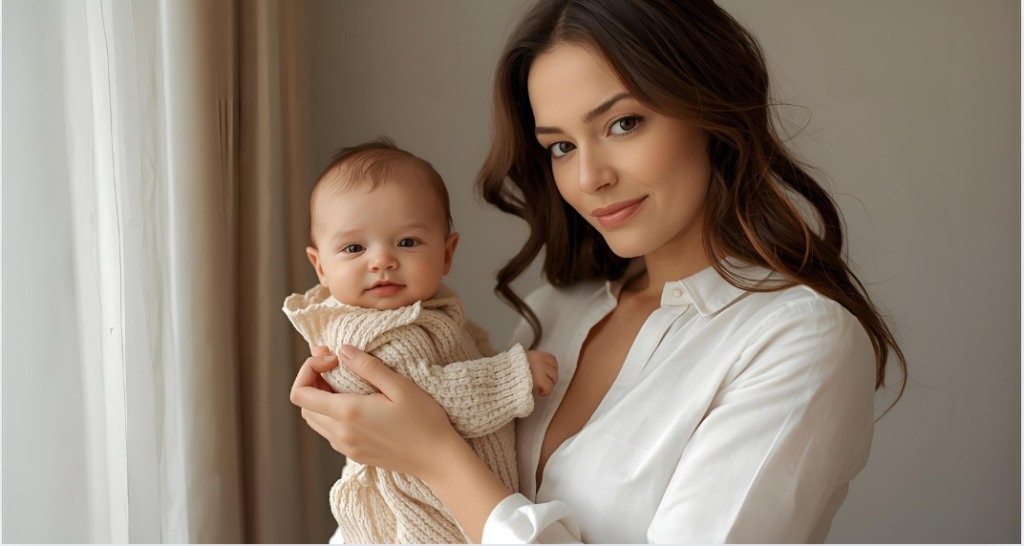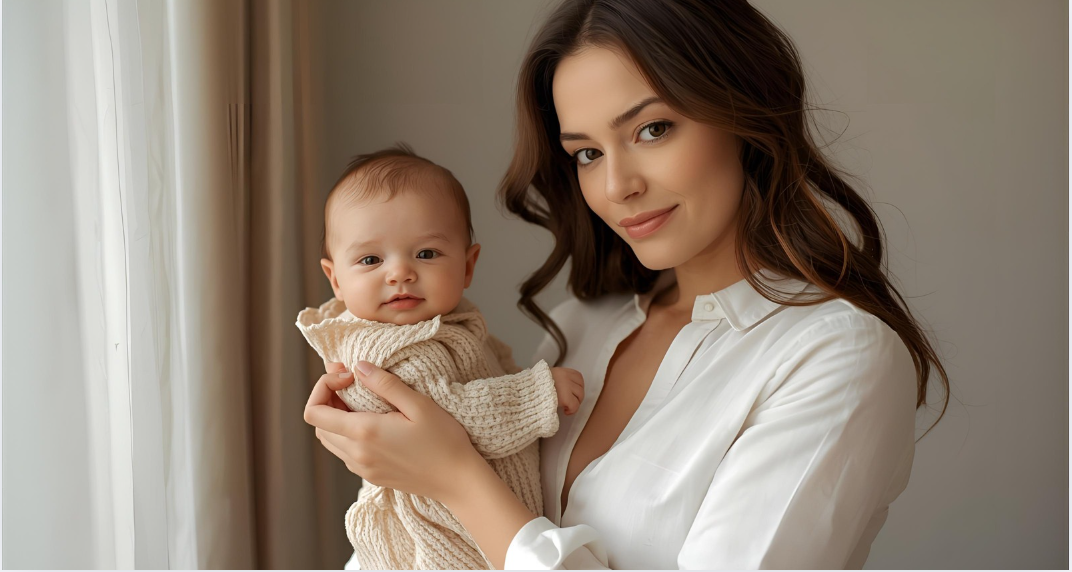When your little one develops a fever, it can be a worrying experience for any parent. Knowing how to dress a baby with a fever is one of the most important steps to ensure comfort and help regulate your baby’s body temperature safely. Dressing your baby correctly can make a big difference in how they recover — keeping them comfortable without overheating or chilling.
In this detailed guide, we’ll cover the best clothing options, temperature tips, dos and don’ts, fabric choices, and safety precautions for managing your baby’s fever. Whether you’re a new parent or an experienced caregiver, this article provides everything you need to know to keep your little one comfortable, cool, and cared for.
🌡️ Understanding a Baby’s Fever

Before you decide how to dress a baby with a fever, it’s essential to understand what a fever means.
A fever isn’t an illness — it’s the body’s natural defense mechanism. When your baby’s body temperature rises above normal (usually 100.4°F or 38°C), it’s a sign that their immune system is fighting off an infection.
Normal and Fever Temperature in Babies
- Normal baby temperature: 97.5°F – 99°F (36.5°C – 37.2°C)
- Mild fever: 100.4°F – 101.3°F (38°C – 38.5°C)
- Moderate to high fever: 101.4°F – 104°F (38.6°C – 40°C)
Fever can cause sweating, chills, irritability, and dehydration. That’s why dressing your baby appropriately plays a crucial role in regulating their comfort and body temperature.
👕 How to Dress a Baby With a Fever: The Golden Rule

The golden rule is: Dress your baby in one light layer more than you would feel comfortable wearing yourself.
Overdressing can trap heat and worsen the fever, while underdressing can make your baby shiver — which raises body temperature even more. Finding the right balance is key.
Here’s how to get it right.
🧸 Step-by-Step Guide: How to Dress a Baby With a Fever
1. Start With Lightweight, Breathable Fabrics
When your baby has a fever, choose natural, breathable fabrics like:
- Cotton: Soft and gentle on the skin, allows air circulation.
- Muslin: Lightweight and ideal for warm weather.
- Bamboo fabric: Moisture-wicking and temperature-regulating.
Avoid synthetic materials such as polyester or nylon, which trap heat and can make your baby sweaty and uncomfortable.
2. Choose Loose-Fitting Clothes
Tight clothing can restrict airflow and irritate the baby’s sensitive skin. Instead, opt for:
- A cotton bodysuit or onesie.
- Short-sleeve rompers or sleeveless vests in warmer rooms.
- Soft pajamas in cooler environments.
Loose clothing lets heat escape naturally, helping your baby’s body cool down.
3. Keep the Room at a Comfortable Temperature
When thinking about how to dress a baby with a fever at night, room temperature is just as important as clothing.
Keep the room between 68°F and 72°F (20°C–22°C). Use a fan for gentle air circulation if needed, but avoid blowing it directly onto your baby.
You can use a light cotton blanket or sleep sack if your baby feels chilly, but never over-layer.
4. Avoid Heavy Blankets or Swaddles
When your baby has a fever, avoid:
- Fleece blankets
- Quilts or thick comforters
- Swaddling tightly
These trap heat and can cause overheating. Instead, use a thin muslin or cotton sheet if necessary.
5. Monitor Your Baby’s Temperature Frequently
Check your baby’s temperature every few hours using a reliable thermometer:
- Rectal thermometers are most accurate for infants under 3 months.
- Forehead (temporal) or ear thermometers work well for older babies.
Adjust your baby’s clothing as their temperature changes — if the fever breaks and they start sweating, remove a layer to prevent chilling.
6. Dress According to Fever Stages
Fever often comes in stages — rising, peaking, and falling. Here’s how to adjust clothing for each:
Rising Stage (Baby feels cold or shivering):
- Dress in one comfortable layer such as cotton pajamas.
- Lightly cover with a soft blanket until shivering stops.
Peak Stage (Baby feels hot and flushed):
- Remove extra layers.
- Use a light onesie or diaper-only with a thin blanket.
- Wipe with a lukewarm (not cold) damp cloth to help cool the skin.
Falling Stage (Fever breaks and baby sweats):
- Change into dry, breathable clothes.
- Replace damp clothing quickly to prevent chills.
7. Keep Baby Hydrated
Although not directly about dressing, hydration is crucial. Fever causes fluid loss, and dehydration makes babies feel more unwell. Offer:
- Breast milk or formula for infants
- Water (if older than 6 months) in small sips
- Oral rehydration fluids if recommended by a doctor
Hydration helps the body regulate temperature naturally.
8. How to Dress a Baby With a Fever at Night
Nighttime can be tricky — babies often sweat more or feel chilled during fever fluctuations.
Night dressing tips:
- Use a short-sleeved cotton sleep suit or bodysuit.
- Skip the thick blankets and heavy pajamas.
- Keep a light sheet or breathable sleep sack nearby in case the baby feels cold.
- Check your baby’s chest or neck — if they’re sweaty, they’re too warm; if their hands and feet are cold, add a thin layer.
🧦 What to Avoid When Dressing a Baby With a Fever
Many parents accidentally overdress or overcool their baby, which can make the fever worse. Avoid these common mistakes:
❌ 1. Avoid Over-Bundling
Do not pile on layers, hats, or mittens when your baby has a fever. Babies lose heat through their heads and extremities — covering them traps unnecessary warmth.
❌ 2. Avoid Ice-Cold Baths or Wet Clothes
While it might seem logical to cool your baby fast, cold baths or ice packs can cause shivering, which raises internal body temperature instead of lowering it.
❌ 3. Avoid Tight, Synthetic, or Wool Clothing
Such materials don’t allow ventilation and can cause skin irritation, especially if your baby sweats during a fever.
❌ 4. Avoid Scented Lotions or Heavy Ointments
These can block pores and make it harder for your baby’s skin to release heat naturally.
🧵 Best Fabrics to Choose When Dressing a Baby With a Fever
| Fabric Type | Breathability | Skin Comfort | Recommended For |
|---|---|---|---|
| Cotton | Excellent | Soft and lightweight | All temperatures |
| Muslin | High | Ultra-light and airy | Hot climates |
| Bamboo | Very high | Moisture-wicking | Sensitive skin |
| Linen blend | Good | Cool and natural | Daytime wear |
| Fleece/Wool | Poor | Too heavy | Avoid during fever |
🍼 Signs That Your Baby Is Dressed Too Warm or Too Cold
Too Warm:
- Sweating or damp hair
- Flushed face or rash
- Rapid breathing
- Irritability or lethargy
Too Cold:
- Cool hands, feet, or nose
- Pale or blotchy skin
- Baby shivers or feels stiff
Check your baby’s chest or back — this is the most accurate indicator of comfort, rather than the hands or feet.
💧 Bonus Tips for Managing Fever Comfortably
- Offer cool fluids frequently.
- Use a soft, damp washcloth on the forehead or underarms.
- Keep lights dim and noise low — fever makes babies irritable.
- Avoid direct sunlight or drafts.
- Give medication only under doctor’s guidance.
- Keep track of temperature patterns for your pediatrician.
❓ FAQs About How to Dress a Baby With a Fever
1. Should I let my baby sleep in just a diaper during a fever?
If the fever is high and your baby feels hot to touch, yes — sleeping in a diaper alone in a comfortable room temperature (around 70°F / 21°C) is safe. Cover lightly with a cotton sheet if needed.
2. Is it okay to use socks or hats when a baby has a fever?
No. Hats and socks trap heat and prevent the baby’s body from cooling down. Keep your baby’s head and feet uncovered unless they feel cold to touch.
3. Can I give my baby a cold bath to lower the fever?
Avoid cold or ice baths. Instead, give a lukewarm sponge bath for 5–10 minutes. This helps reduce temperature gently without triggering shivering.
4. What’s the best outfit for a baby with fever in summer?
A light cotton bodysuit or sleeveless romper is ideal. Keep the room airy, and avoid any blankets or heavy bedding.
5. How can I tell if my baby is overheating?
Check your baby’s chest or back — if it feels hot and sweaty, remove a layer. Overheating can make the fever worse and may cause heat rash.
6. What should my baby wear after the fever breaks?
Once your baby’s fever drops and they start sweating, change them into fresh, dry cotton clothes immediately to prevent chills. Continue dressing lightly until their temperature stabilizes.
7. Should I use a fan or air conditioner if my baby has a fever?
Yes, you can use them for comfort — but keep the air indirect. The goal is to maintain a cool, steady temperature, not to blast cold air on your baby.
8. My baby’s hands and feet are cold but they’re sweating. Is that normal?
Yes. During fever recovery, blood circulation may fluctuate, causing cool hands and feet while the core stays warm. Dress based on chest temperature, not extremities.
9. Should I apply warm clothes if my baby has chills?
Mild chills are common when fever rises. Add a light layer or blanket temporarily until the shivering stops, then remove it to prevent overheating.
10. How long should I keep dressing my baby lightly after a fever?
Continue dressing your baby in light, breathable clothes for at least 24 hours after the fever breaks, as temperature may fluctuate slightly during recovery.
🩺 When to See a Doctor
If your baby:
- Is under 3 months old and has a fever above 100.4°F (38°C)
- Shows persistent fever above 102°F (38.9°C)
- Has trouble breathing, poor feeding, or persistent vomiting
- Appears unusually drowsy, irritable, or unresponsive
- Has a rash that spreads quickly
Seek medical help immediately. Fever is usually harmless but can sometimes indicate infection requiring treatment.
🌼 Conclusion: Dressing Your Baby Comfortably and Safely During a Fever
Knowing how to dress a baby with a fever is a crucial part of providing comfort and care during illness. Your goal should be to keep your baby cool, not cold; warm, not hot — achieving balance through breathable fabrics, light layers, and attentive monitoring.
Always remember:
- Use lightweight natural fabrics like cotton or muslin.
- Avoid heavy blankets, tight clothing, and synthetic materials.
- Keep the room comfortable and airy.
- Adjust layers as your baby’s fever rises or falls.
By following these steps, you can help your baby’s body recover naturally and comfortably while avoiding unnecessary stress.
Fever is part of the healing process — with proper care, hydration, and gentle clothing choices, your little one will be back to their happy, healthy self in no time. 💖

